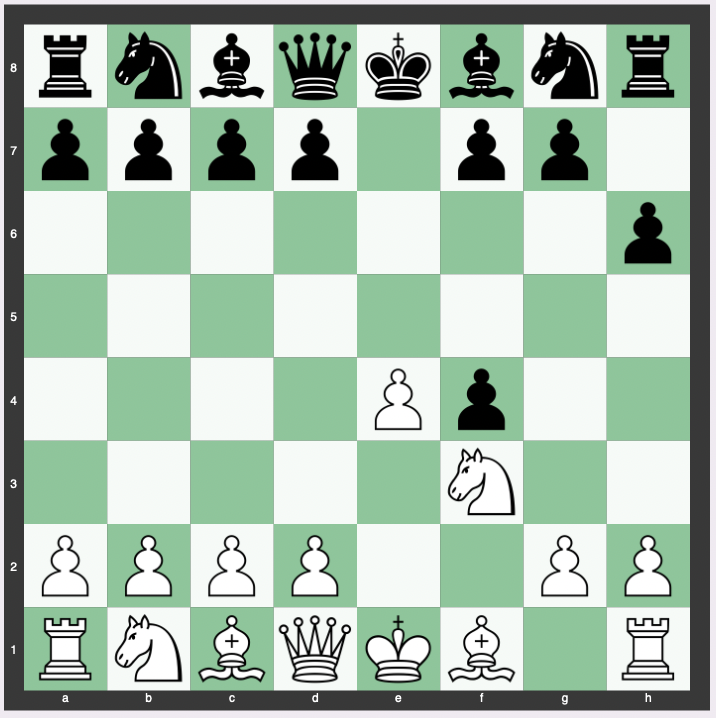The Becker Defense in chess is denoted by the moves 1. e4 e5 2. f4 exf4 3. Nf3 h6 within the context of the King’s Gambit.
Named after its propounder, this defense has a unique strategic concept revolving around creating a defensive pawn chain on h6, g5, and f4 to safeguard the f4 pawn.
It has the added advantage of circumventing the Kieseritzky Gambit, providing black a reprieve from the necessity of playing …g4 when white attempts to undermine the chain with h4.
Understanding the Becker Defense
The Becker Defense, at its core, is a novel way for Black to fortify their position and deter their opponent from taking certain aggressive actions.
Its move order goes:
1. e4 e5 2. f4 exf4 3. Nf3 h6

At the move 3.Nf3 h6, Black aims to create a sturdy pawn chain on h6, g5, and f4.
This pawn chain effectively guards the f4 pawn, a critical defensive piece.
Avoiding the Kieseritzky Gambit with the Becker Defense
An additional benefit of the Becker Defense is its strategic provision to avoid the Kieseritzky Gambit.
The Kieseritzky Gambit can put Black in an unfavorable position, where the player might be forced to play …g4 as a defensive move when White undermines the pawn chain with h4.
The Becker Defense skillfully circumvents this situation, offering Black a safer pathway.
White’s Response and Options to the Becker Defense
As the match progresses, White has a couple of response options.
One viable response is 4.b3, introducing flexibility in the development of White’s pieces and potentially opening up diagonals for the bishop.
This move is an interesting divergence, though it is not the most common response.
Main Line of Becker Defense
The main line in Becker Defense continues with 4.d4 g5. This move sequence falls under the ECO (Encyclopedia of Chess Openings) code C37.
The progress of the game generally takes the match toward the lines of the Classical Variation, specifically after the sequence 5.Bc4 Bg7 6.0-0, an arrangement which is categorized under ECO code C38.
Evaluation of the Becker Defense
The Becker Defense is generally evaluated at around -0.10 to -0.50 for white.
Continuation Lines Within the Becker Defense
4. d4 or 4. Nc3 is considered the best continuation for white within the Becker Defense.
4. d4 is considered a stronger overall move, but 4. Nc3 is close.
If playing 4. Nc3, white will have to prepare for both 4…g5 and 4…d6 replies.
Same continuation lines include:
4. d4
4. d4 g5 5. h4 Bg7 6. hxg5 hxg5 7. Rxh8 Bxh8 8. g3 Nc6 9. Nc3 d6 10. gxf4 gxf4 11. Bb5 Kf8 12. Bxc6 bxc6 13. Bxf4 Bg4 14. Qd3 Bxf3 15. Qxf3 Bxd4 16. Qg3 Qe7 17. O-O-O Bxc3 18. bxc3 Qxe4
4. d4 g5 5. g3 d6 6. Nc3 fxg3 7. hxg3 Bg7 8. Be3 Nf6 9. Qd3 Ng4 10. O-O-O Nxe3 11. Qxe3 Be6 12. d5 Bg4 13. e5 O-O 14. e6 fxe6 15. dxe6 Nc6 16. Bc4 Ne7 17. Be2 Bf5 18. Rhf1 Bh3 19. Rh1 Bg2 20. Rhg1
4. d4 g5 5. g3 fxg3 6. hxg3 Bg7 7. Nc3 d6 8. Qd3 Nc6 9. Be3 Nf6 10. O-O-O Ng4 11. Nh2 Be6 12. a3 Nxe3 13. Qxe3 Ne7 14. Be2 c6 15. Bh5 Qb6 16. Rhf1 O-O 17. Ng4 c5 18. Nf6+ Bxf6 19. Rxf6 cxd4 20. Rxd4
4. d4 g5 5. Nc3 d6 6. g3 fxg3 7. hxg3 Bg7 8. Be3 Nf6 9. Qd3 Nc6 10. O-O-O Ng4 11. Nh2 Be6 12. Nxg4 Bxg4 13. Be2 Bxe2 14. Qxe2 Qd7 15. Rhf1 Rf8 16. Nd5 O-O-O 17. Nf6 Bxf6 18. Rxf6
4. Nc3
4. Nc3 g5 5. g3 d6 6. d4 fxg3 7. hxg3 Bg7 8. Be3 Nf6 9. Qd2 Ng4 10. O-O-O Nd7 11. Bc4 Nxe3 12. Qxe3 Nb6 13. Bb3 Be6 14. Bxe6 fxe6 15. e5 Qe7 16. exd6
4. Nc3 g5 5. d4 d6 6. g3 fxg3 7. hxg3 Bg7 8. Be3 Nf6 9. Qd2 Ng4 10. O-O-O Nd7 11. e5 Nb6 12. exd6 Qxd6 13. Nxg5 hxg5 14. Nb5 Qd7 15. Rxh8+ Bxh8 16. Bxg5 Kf8 17. Re1 Qc6 18. Be7+ Kg8
4. Nc3 g5 5. g3 fxg3 6. hxg3 Bg7 7. d4 d6 8. Be3 Nf6 9. Qd2 Ng4 10. O-O-O Nxe3 11. Qxe3 Be6 12. Be2 Qe7 13. Rdf1 c6 14. Kb1 Nd7 15. d5
4. Nc3 g5 5. g3 fxg3 6. hxg3 d6 7. d4 Bg7 8. Be3 Nf6 9. Qd3 Nc6 10. O-O-O Ne7 11. Bd2 O-O 12. Nxg5 hxg5 13. Bxg5 Nh7 14. Rxh7 Kxh7 15. Nd5 Bh6 16. Nf6+ Kg6 17. Bxh6 Rh8 18. e5+ Kxh6
4. Nc3 d6 5. h4 Nf6 6. Bc4 Nc6 7. d4 Nh5 8. Nd5 Ng3 9. Rh2 Ne7 10. Nxf4 Nxe4 11. Qe2 Nf6 12. Bd2 Bg4 13. O-O-O d5 14. Bb3 Qd7 15. Qe3 Bxf3 16. Qxf3 O-O-O 17. c3 Nc6 18. Nd3 Re8 19. Rhh1 Na5 20. Bc2 Nc4 21. Ne5 Nxe5 22. dxe5 Rxe5 23. Bf4 Re7 24. g4 Kb8
4. Nc3 d6 5. d4 g5 6. g3 fxg3 7. hxg3 Bg7 8. Qd3 Nc6 9. Be3 Nf6 10. O-O-O Ng4 11. Nh2 Be6 12. Nxg4 Bxg4 13. Be2 Bxe2 14. Qxe2 Qd7 15. Rhf1 a6 16. Qh5 Rf8 17. g4 O-O-O 18. Kb1 Qe8 19. a3 f5 20. Qxe8 Rdxe8 21. gxf5 Ne7 22. Bg1 Kd7
ECO C34 King’s gambit accepted, Becker defense (White perspective)
Conclusion
In the vast universe of chess openings and defenses, the Becker Defense shines as an innovative strategy for Black to solidify their defensive position.
It introduces a unique concept of a defensive pawn chain while also enabling Black to avoid the complexities of the Kieseritzky Gambit.
Although White has options to respond, the main line of the Becker Defense tends to lead the game toward the Classical Variation.
As with all chess strategies, understanding and utilizing the Becker Defense effectively requires study and practice, but mastering it can provide an alternative defensive tactic in the complex and intriguing game of chess.


